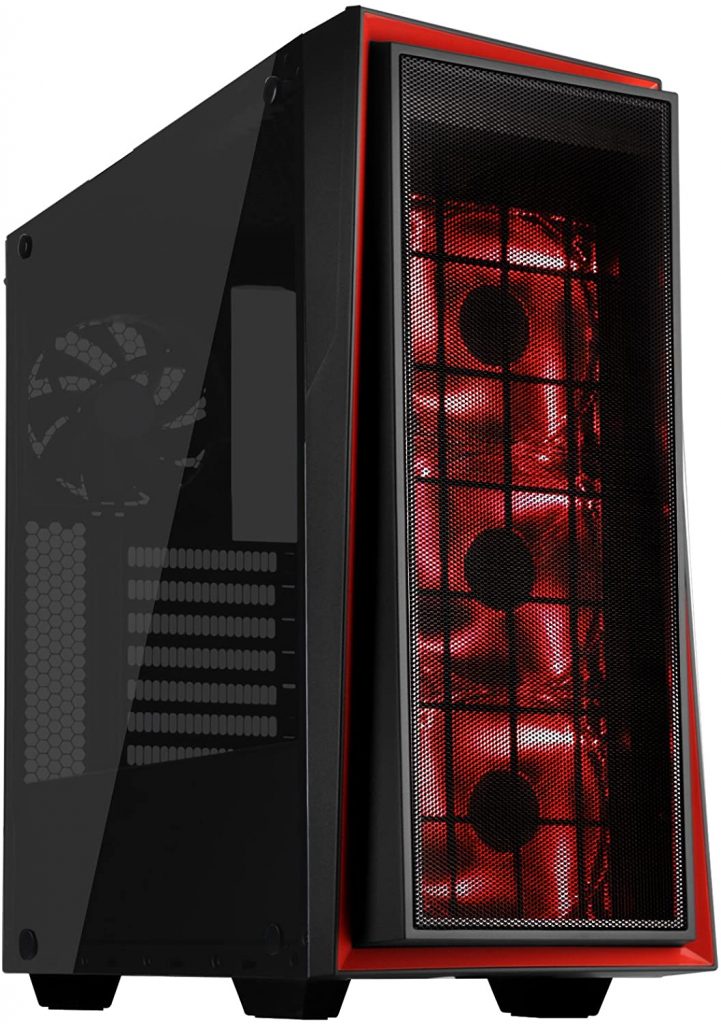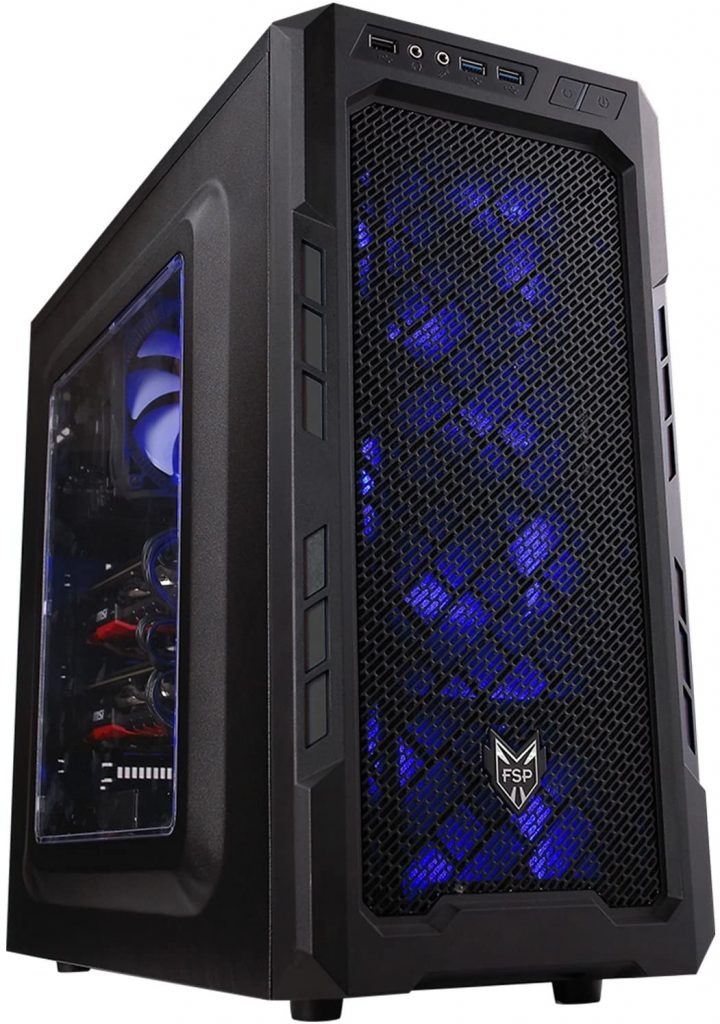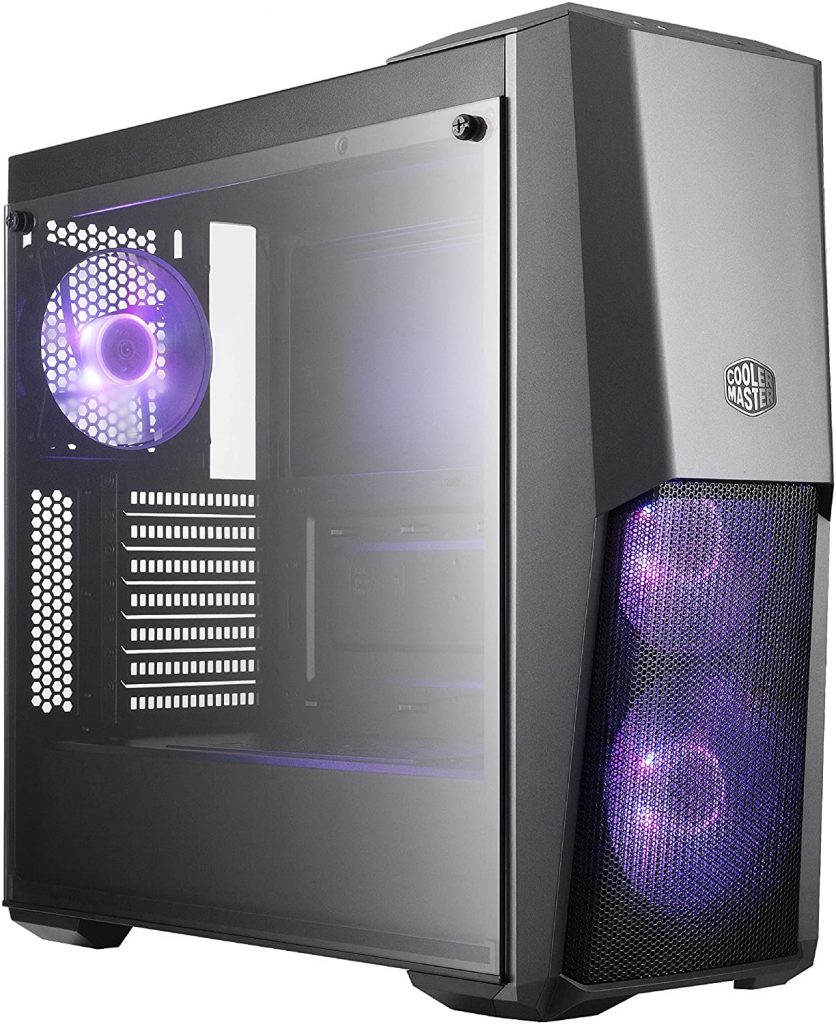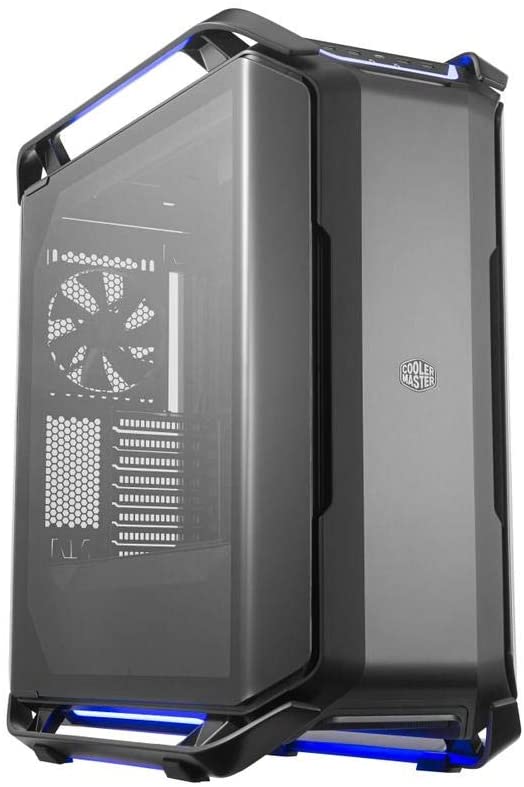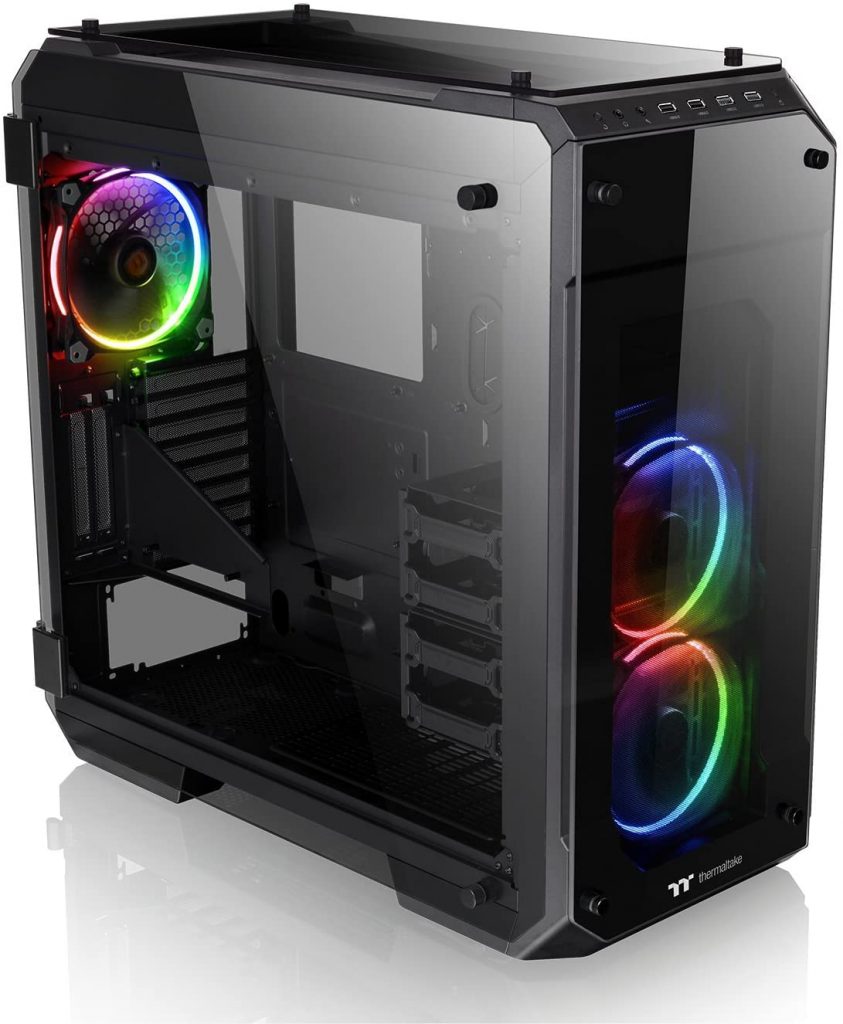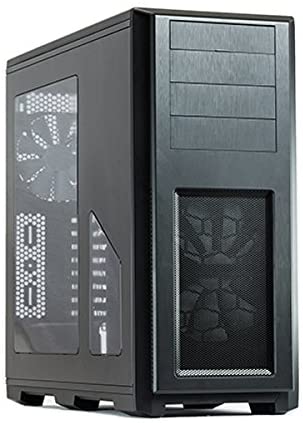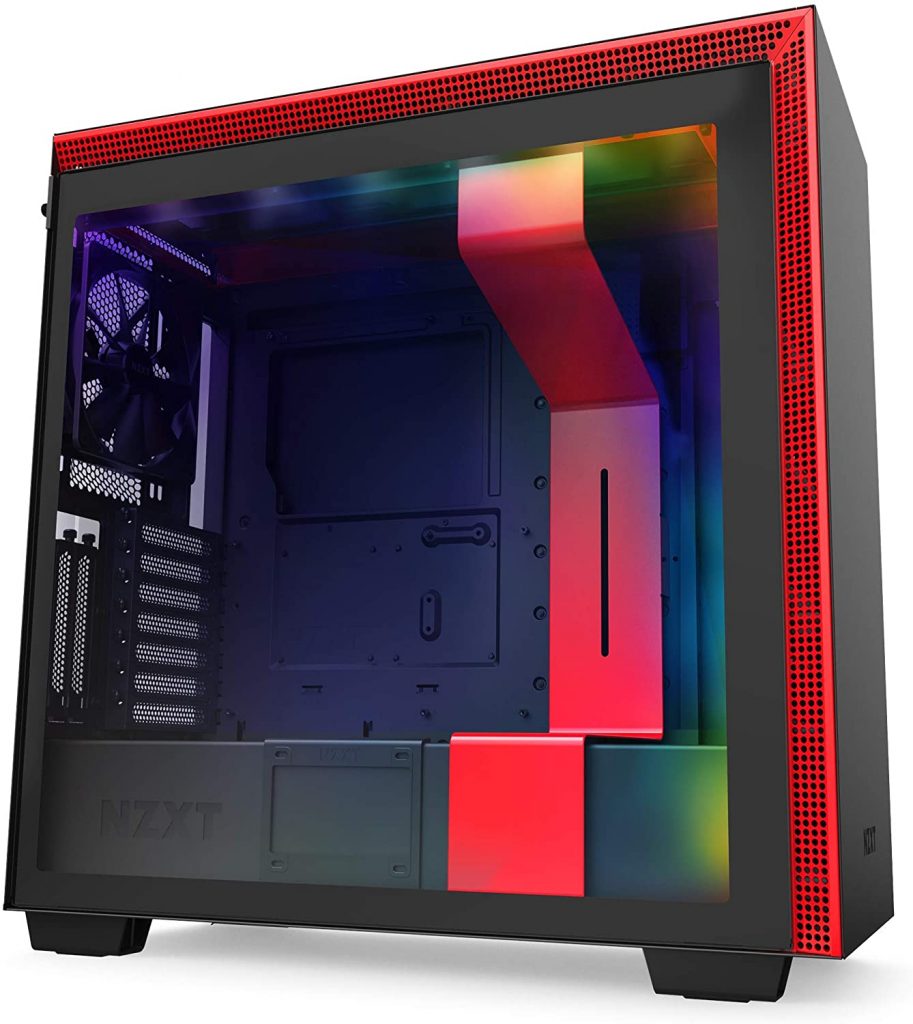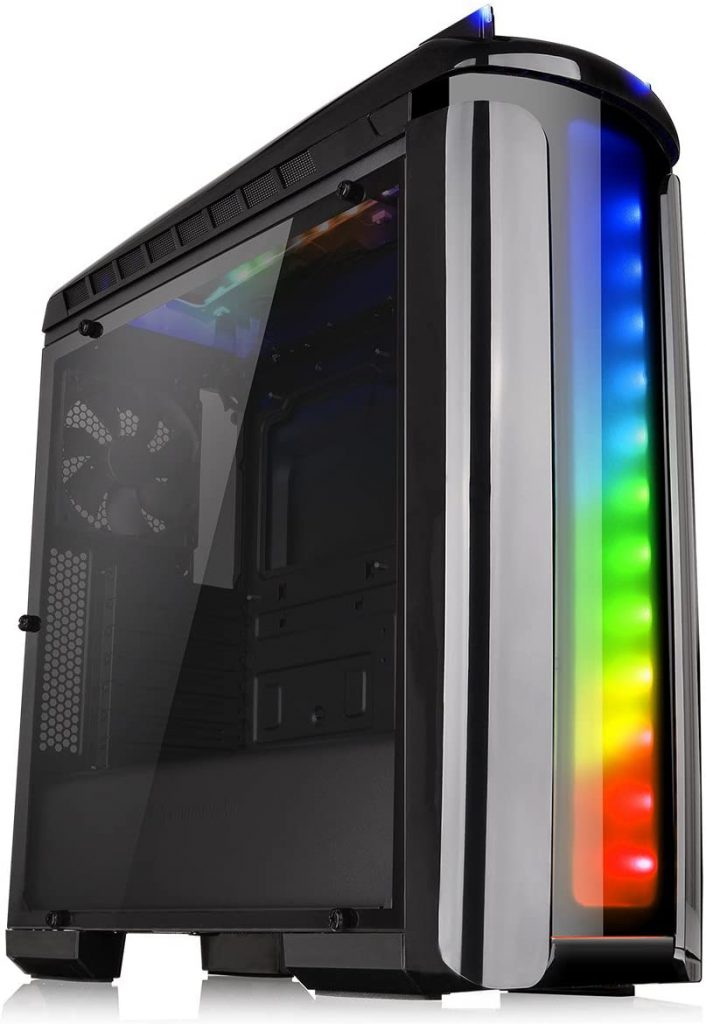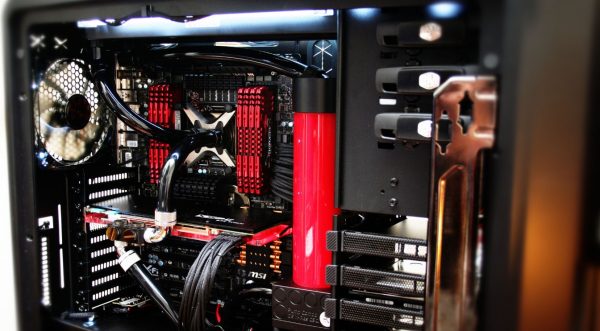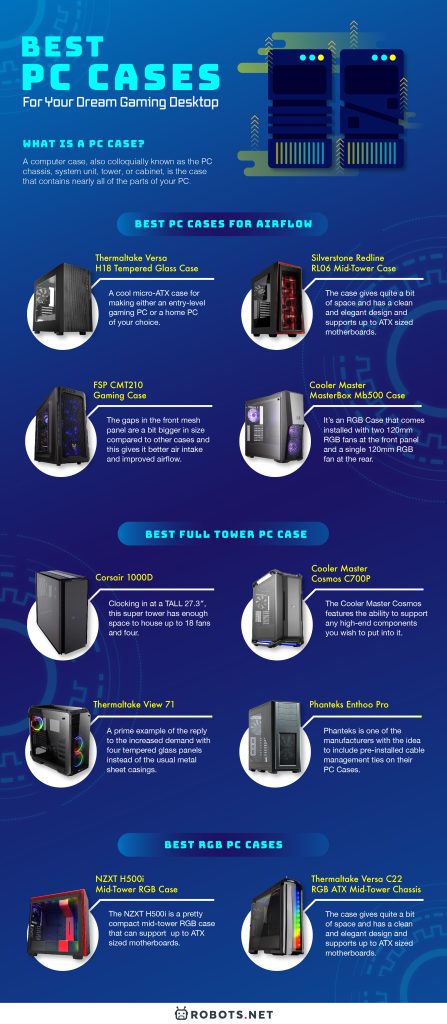Best PC Cases For Airflow
Best Full Tower PC Case
Best RGB PC Cases
What is a PC Case?
It has the ability to accommodate powerful graphics cards below and up to 355mm in length, 155mm tall CPU coolers for air cooling, and up to 280mm Radiators for AIO liquid cooling for those who want it. It’s also pretty good in the storage department as you can put two 3.5-inch and two 2.5-inch drives inside the PC case. It also has a tempered glass panel window on one of its sides so that the user can have a good look at your parts from outside. Other features that come with this PC case that are wonderful additions include good cable management and tool-free drive installation. The case supports below and up to 348mm long graphics cards, up to 158mm tall CPU coolers and gives you the ability to install upwards to 240mm Radiators for AIO liquid cooling. The build quality of this PC case is great and it has tempered glass side panels like the RL06 if you wish to see your hard-earned gaming components. Other features this case has include dust filters at the front, top, and bottom of the case, a PSU and drive bay cover, an integrated 3-pin Fan controller for the 10 fans it can accommodate, cable management, and a tool-free drive installation. The PC case supports graphics cards below and up to 360mm in length, 160mm tall CPU air coolers, and upwards to 360mm Radiators for those who wish for Water cooling. In the storage department, you can place a maximum of 3 3.5-inch drives and 3 2.5-inch drives. Other features of note include a Translucent Window Panel, a Tool-free drive installation for an easier time, and cable routing. Overall, it’s a great budget mid-tower case that has good airflow, and you can bet that it’s a recommended PC Case for building a budget or even a mid-range gaming PC. The case has a semi-meshed front panel with hexagonal vents and the layout works pretty well in the goal of proper airflow and ventilation. The case gives a good amount of space for all the high-end gaming components you might want to get and supports up to ATX motherboards. Front I/O ports include 2 USB 3.0 ports and Audio ports for your speakers and headphones. A 4mm thick tempered glass panel allows you the ability to view all the inside parts of your PC Case and showcase them to others. The case can support below and up to 400mm long high-end graphics cards, 160mm tall CPU air coolers, and up to 360mm Radiators for use of water cooling. You can also add up to 2 3.5-inch and 2 2.5-inch drives for your storage and memory needs. Other features include a dust filter, easy cable routing, and tool-free drive installation. The Corsair 1000D is a wee bit bigger than what many PC enthusiasts would call a full tower. In fact, it’s actually called a super tower by its creators due to how big it is. It’s a huge PC case that’s ready to house the biggest and PC systems that you and your budget can muster. Clocking in at a TALL 27.3″, this super tower has enough space to house up to 18 fans and four. Yes, you heard right. FOUR massive radiators at the same time. In addition to the utterly ludicrous cooling support this PC case gives you, the 1000D also features a unique triple-chamber design that comes with some convenient French-door-styled storage compartments and telescoping radiator trays so that you can have an easy time installing them. It’s a case that is so, so huge, it can house a whole E-ATX build and another mini-ITX build all at the same time. An understated RGB light bar system is integrated on the top and bottom of the case that helps illuminate the exterior in a pretty cool and tasteful manner that doesn’t distract you from the build’s overall aesthetics. Another upgrade from the already cool original is the new curved tempered glass panel that gives you the chance to showcase the whole build. As you can expect from a PC case like this, the Cooler Master Cosmos features the ability to support any high-end components you wish to put into it. This includes E-ATX motherboards, multiple graphics cards of any size and radiators that go up to 420mm in length. The only minor grump that some people might have with the case’s size and capabilities is the potential issues you might get on routing accessories and power cables if you go with certain motherboard tray configurations. Other than that though, this is a great PC case if you want to have a PC Rig that you wish to show off while still having the capabilities to do what you want with it. The View 71 RGB is quite possibly the best full-sized tower you’ll get if you’re an RGB enthusiast. The tempered glass (Tinted as well, no expense is spared for this baby.) does a pretty cool job making sure that the rig’s internal lighting stands out. And compared to some of the other tempered glass cases you’ll see in the market, the View 71 ALSO comes with swinging doors so that you don’t need to remove the glass panels if you want to make a few changes. The case also includes a sweet vertical GPU mount and an extensive liquid cooling support if you’re going for all-in-one and custom loops. If you have an inkling to buy a big case with e-ATX support, a liking for pretty colors, and other cool doodads, the View 71 is the case for you. Phanteks is one of the manufacturers with the idea to include pre-installed cable management ties on their PC Cases. This feature helped make a huge world of difference when it comes to the admittedly tedious task of cable management that is atypical to these things. The case also gives builders a lot of flexibility which makes it a great buy for all sorts of large PC builds. When you pull it out of the box, you’ll see that the case comes with a 200mm fan in the front panel and an additional 140mm fan in the rear panel. This is usually enough to give quite a bit of airflow in the PC case. However, the top panel also lets you take things even further beyond (Plus Ultra!) with the ability to support a radiator up to 420mm in size. In short, the Phanteks Enthoo Pro is a great PC case to start your PC building in. The case can support CPU coolers that can range up to 165mm tall, graphics cards going up to 481mm long, and 280mm radiators for those that want liquid cooling. It also comes with an in-built fan controller/RGB controller as well as 2 internal RGB LED strips. There’s one at the top and another one right behind the cable management bar for the case. The RGB lighting and effects that the case has can be controlled through the NZXT CAM software. In addition, the RGB/Fan controller can support up to four LED lighting strips or five RGB fans. The case also HAS Adaptive Noise Reduction technology. This actively adjusts the speed your fan is spinning depending on the noise that the tech is measuring as well as the temperatures of your CPU/GPU. You can get upwards to 40% noise reduction and provide you with an optimal balance between PC cooling and silence. The case has a tempered glass side panel from where you can see the RGB lighting and effects clearly. Other features the case has include dust filters and easy cable management. This mid-tower case can accommodate your high-end graphics cards all the way up to 390mm in length, the various CPU Coolers up to 160mm in height, and any myriad of 240mm radiators for AIO and DIY liquid cooling solutions for your pleasure. It has a transparent side panel if you wish to show off your sick rig, removable dust filters for easy cleaning, and a tool-free drive installation so that you don’t have the hassle of screws. All in all, a great rig for any prospective PC builder. Your typical PC cases are constructed from steel (oftentimes from SECC—steel, cold-rolled, coil, electro-galvanized), plastic, and aluminum. Although, other materials like glass, acrylic, wood, and even Lego bricks are also viable. And are usually custom, home-built cases.
Layout
PC cases usually have sheet metal covers for its drive bays and power supply unit. And also includes a rear panel that allows other peripheral connectors that stick out from your PC cases like the motherboard and other expansion slots space. Many PC cases also have a power switch/button, a restart button, and LEDs that indicate hard drive activity, power, and network activity in some advanced models. There are some cases that also include built-in I/O ports like USB and headphone ports on the front part of the case.
Major component locations
The PC’s motherboard is usually screwed to the case alongside its largest face. This part of the case could be the bottom or the side of your PC case. As to where it could be, this depends on your PC case’s form factor and orientation. Form factors like the ATX give a back panel that has cut-out holes in order to expose I/O ports given by various integrated peripherals. Bigger ATX cases are also used with motherboards of other various form factors. The place where you mount the power supply unit differs from PC case to PC case. However, the commonly used locations are both at the back of the case (For good reasons). Their Advantages and disadvantages are: The top of the case: This configuration usually allows the PSU’s built-in fan to also be an auxiliary exhaust fan. However, this causes your PSU to suck in air that’s been heated by the other internal components of your PC case. This can cause PSU lifespan and efficiency degradation. The bottom of the case: with a filtered vent in the bottom. This allows the PSU to get cool air from outside the case, giving it a longer lifespan.
Regardless of your preferred mounting position, your PSU is usually attached to the PC case with four screws in order to support its weight.
Most cases also include drive bays on the front part of the PC case. Your typical ATX case usually has 5.25″, 3.5″ and/or 2.5″ bays. In modern PC’s, the 5.25″ bays are usually for optical drives, the 3.5″ bays are for card readers and HDD’s, while the 2.5″ bays are for SSD’s. Buttons and LEDs are usually found in front of the case. Though some cases also have additional I/O ports, temperature monitors, processor speed monitors, and other inclusions in the same area. The vents of your PC Case are usually on the front, back, top, left side panel, and sometimes on the Case’s right side panel. Regardless of the placement, their purpose is to let cool air in the PC case or to let hot air OUT. Either one of the two. Larger vents generally allow cooling fans to be mounted through the threaded screw holes surrounding it. Meanwhile, newer cases have mountings for bigger 120mm or 140mm cooling fans for quieter operation compared to the 80mm fans that were common back in the day.
PC Case Form Factors
The first thing you need to know is that PC cases come in many different shapes and sizes. These are more commonly known as form factors. The shape and size of a PC case are typically determined through the form factor of the motherboard in question since it’s usually the biggest component of most PCs. As a consequence, PC form factors usually specify only the internal dimensions and layouts of the PC case in question. Form factors for the rack-mounted and blade servers might also include precise external dimensions as well This is because these cases must fit in specific enclosures themselves.
PC Case Size
A case made for an ATX motherboard and power supply can take on some external forms like a vertical tower case (height > width), a flat desktop case (height < width), or a pizza box case (height ≤ 5 cm (2 in)). Full-size tower cases are usually larger in volume compared to desktop cases, they also tend to have more room for drive bays, expansion slots, and other custom parts including water cooling, and more. Meanwhile, Desktop cases and mini-tower cases that are under 46 cm (18 in) in height are usually used in many business environments where space is premium.
Small Form Factors
Right now, the most popular form factor for desktop PCs is ATX. Though microATX and other small form factors are also becoming popular for a wide variety of uses. In the high-end of the spectrum, the loosely defined XL-ATX form factor specification appeared in around 2009. It extended the length of the mainboard in order to accommodate four graphics cards that have dual-slot coolers. There are also some XL-ATX mainboards that increase the mainboard’s width as well in order to give more space for the CPU, Memory PWM, and in some rare cases, even a 2nd CPU socket. Although the market share of these unique high-end mainboards is very low, nearly all high-end cases and a lot of mainstream cases have the capability to support XL-ATX (10 expansion slots). Meanwhile, High-end mini ITX mainboards have the ability to support standard desktop CPUs, can use memory DIMM sockets, and usually features a full-size PCI-E 16× slot that can support current graphics cards Though some use a PCI instead or a PCIe slot that’s less than 16 lanes. This gives customers the ability to build a full-fledged high-end PC in a smaller case.
Tower Cases
Meanwhile, tower cases are categorized as the mini-tower, midi-tower, mid-tower, or full-tower types of PC cases. These terms are pretty subjective and are defined as inconsistently by different manufacturers. Full tower cases are big boys and typically clock in at 56 cm (22 in) or more in the height department and are usually intended to stand on the floor. They can get anywhere from 6 to 10 external access drive bays. But as PC technology moves from the floppy disks and CD-ROMs of the past towards large capacity HDD’s, USB flash drives, and current network-based solutions, the current full tower cases of today usually have one or two external bays for CD drives, with internal bays placed elsewhere in the PC case to have improved airflow. Now, full tower cases are usually used by PC enthusiasts as a showpiece display case that comes with custom water cooling, lighting, and other cool stuff.

